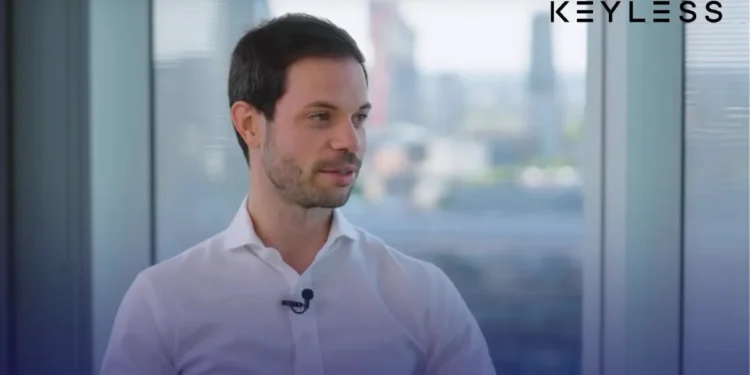In this insightful interview, Fabian Eberle, CEO and co-founder of Keyless, discusses the future of banking authentication technologies, the benefits of privacy-preserving biometrics, and how Keyless is changing the industry. Here’s a breakdown of their conversation.
Who is Fabian Eberle?
Fabian Eberle is the Chief Operating Officer (COO) and Co-Founder of Keyless Technologies, a company specializing in privacy-preserving biometric authentication solutions. Since its inception in December 2018, Keyless has pioneered the use of privacy-enhancing technologies (PETs) for biometric authentication and identity management.
Intail AI – Relationship-Driven Growth
Before establishing Keyless, Fabian worked as a Management Consultant at McKinsey & Company from October 2014 to December 2018, focusing on digital strategy and global transformations. Prior to that, he completed a traineeship at SAP SE, gaining experience in strategy, business development, marketing, consulting, and sales.
Q1: Could you briefly introduce yourself to our audience and tell us about Keyless?
Fabian: Certainly! My name is Fabian Eberle, and I am the CEO and co-founder of Keyless. Keyless is a pioneer and leader in privacy-preserving biometric authentication. We work with banks to help reduce account takeover fraud and enhance the user experience. Our solutions focus on improving the authentication process across the entire user lifecycle—from initial login and payment authorizations to account recovery, without relying on SMS OTPs.
Q2: How does Keyless differentiate itself from other biometric technologies in the market?
Fabian: There are three key aspects that make Keyless stand out:
- Privacy-Preserving: We do not store any biometric data, neither on the user’s device nor on the server. This means we can provide biometric capabilities without compromising privacy, allowing regulated entities to avoid storing sensitive data.
- Multi-Factor Authentication: Keyless verifies both the user’s identity and the device they are using. We combine biometric authentication with cryptographic verification, ensuring two distinct factors with a simple glance at the camera.
- Rapid Time to Value: We seamlessly integrate with existing banking systems. We don’t require users to re-enroll for authentication, as we can leverage their initial identity verification to silently enroll them for ongoing biometric authentication.
Q3: Can you explain how privacy-preserving biometrics benefit compliance for financial institutions?
Fabian : When it comes to biometric authentication, there are two main approaches: device-native systems like Face ID, which only unlock the phone, and server-side biometric systems, which ensure the user’s identity but require storing sensitive biometric data. The latter poses a significant risk, especially around compliance, as it involves handling sensitive data that must be protected.
Keyless removes this risk. We provide server-side biometric capabilities without the need to store sensitive biometric data, thus alleviating compliance concerns. Banks can implement biometrics without worrying about managing user consent or protecting personal data.
Q4: How does Keyless integrate with existing banking systems?
Fabian: Integration is seamless. We don’t require changes to existing banking systems or user flows. Keyless works alongside current identity verification processes. When users first create their accounts, they provide a selfie and match it against a government-issued ID, which allows us to silently enroll them for ongoing biometric authentication. We also integrate with identity and access management infrastructures to provide flexible and modular authentication across various parts of the user lifecycle.
Q5: What do you think the future holds for banking authentication in the next five years?
Fabian : In the next five years, we expect a major shift away from traditional methods like passwords, PIN codes, and SMS OTPs. Instead, users will authenticate themselves using who they are—primarily through facial recognition. Once a user verifies their identity with a selfie during account setup, they will be able to reauthenticate across different devices simply by looking into the camera. The need for remembering passwords or using specific devices will be eliminated, making authentication faster and more secure.
Q6: How do you see Keyless contributing to this transformation?
Fabian: Keyless is at the forefront of this transformation. By providing privacy-preserving, multi-factor biometric authentication, we are helping to create a safer and more user-friendly future for banking. We allow banks to authenticate users without compromising privacy, ensuring compliance while eliminating the friction of traditional authentication methods.
During this interview, Fabian’s insights into Keyless highlight a future where biometric authentication is both secure and privacy-preserving, offering banks and users a better way to ensure identity without compromising on user experience. The next five years promise to bring significant innovations, and Keyless is leading the charge toward a more secure and user-friendly authentication system in banking.
For more insights, you can watch the full interview on YouTube: Keyless at Banking Tech Insights – Banks and Privacy-Preserving Biometrics
Read this : India’s Data Centre Market Attracts Over $6.5 Billion Investment in 10 Years










